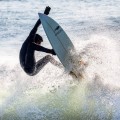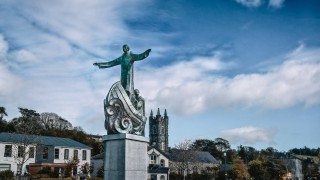
Bantry
The town of Bantry is situated in a small valley at the south-east head of Bantry Bay. A town, which was once traversed by waterways instead of streets, Bantry has in recent years undergone major transformation into a cosmopolitan centre for young and old — a place where the stresses of modern-day living can be forgotten and where the people are noted for their welcome and friendliness.
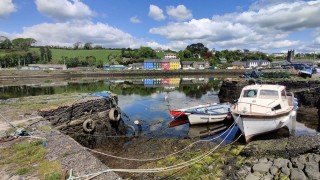
DIRECTIONS
Located on the N71, 85km west of Cork city.
SPECIAL AREAS OF CONSERVATION
Beara Peninsula, Carriganass Castle.
About
Bantry, today, is a hive of activity with its brightly decorated houses and streets. The Town Square has been changed to a large promenade with seating, trees, flowers, an anchor and a centrepiece fountain. A mile of safe footpath with seafront wall, seating and viewing points extends from the town. Being located in the centre of West Cork it is considered the major shopping and commercial centre of the whole West Cork region.
In this breathtaking splendour of mountain scenery, hilly pastures, meandering streams, lakes and woods, where megalithic monuments and ruins of monastic settlements dot the countryside, visitors will find a warm welcome wherever they go.
Information courtesy of Clare Heardman, Bantry.ie and Bantry Tourist Office.
VILLAGES NEARBY: Kealkil
Keakil is a small village located 10km from Bantry. Kealkill stone circle is a significant archaeological site with a radial stone cairn and a pair of standing stones. Visitors to the circle can take advantage of spectacular views with Bantry Bay to the west, Cnoc Baoi to the north and the Sheha Hills to the east.
Discover the Locality
History
A series of walks connect the circle to Carriganass Castle and the Sheep’s Head Way.
The beautiful town of Bantry nestling among drumlins at the head of Bantry Bay, is famed in history and in song.
The history and folklore of this town goes back a long way. According to an ancient Irish manuscript, ‘An Leabhar Gabhala’, known as the Book of Invasions, the first colony to arrive in Ireland landed at ‘Dún na mBarc’ (the fortress of the boats) or Donemark, which is one mile north of the present town of Bantry.
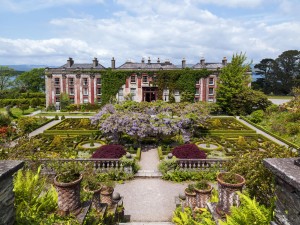
Kealkil stone circle
The area was well populated for many of the early centuries, as evidenced by the many stone circles, megalithic tombs, ring forts and so on, which can be seen dotted around the surrounding countryside. One such example of a stone circle is signposted close to the nearby village of Kealkil, while at the edge of Bantry town stands the famous Kilnaruane Pillar Stone.

The name Bantry (Beanntraí) is reputed to be derived from one of the earliest chiefs of the district, Beannt, a grandson of the famous Conor MacNeasa, King of Ulster in the first century, whose descendants settled in the region. Initially, the name Bantry applied to the bay and surrounding area, while the town at the time had the older name of Ballygobbin (Baile Góban) after St. Goban whose cell is said to have been at KilnaruanePillar Stone.
Bantry town and surrounding countryside was, relatively speaking, sparsely populated, and untouched by outside influences, leaving it completely gaelic up until 1591 when some English merchants arrived. They were lured here by the abundance of fish in the bay, and the enormous shoals of pilchards available in Bantry Bay. Great numbers were employed at the fishing, and the merchants accumulated great riches from the poorly paid labours of the fishermen. The pilchard fish were a great source of fish oil, and a mechanical process was devised to extract the oil from the fish. The oil was then exported.
Bantry Bay is one of the finest and safest harbours in Europe. Being very deep and sheltered, it has been used from earliest times by fishermen and merchant ships as a safe haven. For centuries the fleets of England, Spain, France and Holland fished the bay, paying harbour dues and fishing tax to the O’Sullivan Beres who controlled the bay.
Wolfe Tone
On December 15, 1796 Bantry became the destination of a French Fleet. 43 ships and 15,000 men set sail from Brest in support of the Irish patriot, Wolfe Tone. Tone, a founder member of the United Irishmen, was determined to establish an Irish Republic by armed rebellion. Easterly storms off the Irish coast dispersed the fleet, and while some succeeded in anchoring in Bantry Bay, many were scattered in the Atlantic. On 27th January 1797, an order was given to abandon the attempted invasion, and the remaining sea worthy ships sailed back to France. One ship’s longboat was left behind on Bere Island and stored in Bantry house until the 1940’s, replicas of which are now used worldwide by Atlantic Challenge international for teaching traditional seamanship skills to young people. Bantry Town Commissioners at their very first meeting voted to change the name of the town square from Egerton Square to Wolfe Tone Square in 1896.

It’s interesting to note that many of the principal streets in Bantry town, as we know them today, were actually tidal or waterways up to the nineteenth century. The sea lapped the end of Church Road. In 1832 the Mill Pond Stream, that flows down past the present library, was arched over, together with the Alley River which flows along Glengarriff Road. This formed the streets as well as a small portion of The Square. In 1846 the Square was extended to the Church of Ireland, while in 1895 Bantry Estate donated part of the foreshore plus £500.00 to extend the Square to its present state.
Bantry Museum
While strolling about, why not pop into the quaint little Bantry Museum behind the Fire Station. Here you will find a range of items from bygone days ranging from the famous West Cork Hooded Cloak to the Coomhola anvil, which is a relic of the smelting industry carried on in that side of Bantry.
The museum is run by the Bantry Historical Society and the curators entertain visitors with a mix of historical facts and folklore. (Open June-Aug Tues & Thurs 10am-1pm, Wed & Fri 2-5pm).
Bantry House
Of course, no visit to Bantry is complete without calling to Bantry House, famed for its tapestries and exotic artefacts, with its restored gardens in such a spectacular setting. Bantry House is not only one of the finest historic houses in Ireland, but it also commands one of the best views overlooking Bantry Bay. It has been open to the public since 1946, the first to do so in the country and possibly also in the British Isles.
Bantry House was the principal seat of the Earls of Bantry, ancestors of present-owners, the Shelswell-White family. It has been the residence of the family since about 1765. The Whites originally lived nearby on Whiddy Island, and over the years acquired land in and around Bantry and all along Bantry Bay. In 1765, the family bought Blackrock House on the main land, which was then renamed Seafield House and subsequently, in 1816, Bantry House.
In the winter of 1796, a formidable French Armada, inspired by Theobald Wolfe Tone and the United Irishmen and under the command of Admiral Hoche, sailed from Brest in France. Their purpose was to invade Ireland, put an end to British rule and establish an independent Irish Republic.
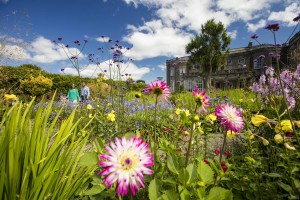
Richard White, the owner of Seafield House, alerted by rumours of the possible invasion, had already raised a militia. The militia consisted mostly of his own tenants, who were loyal to himself and the British Crown. He trained his men and stored their muskets and powder kegs in the basement of Bantry House for safekeeping.
By mid-December that year he had posted lookouts at the furthest seaward reaches of the county (Mizen Head and Sheep’s Head) to bring news as soon as the French fleet was sighted. In the event the weather did his work for him. Huge storms interrupted ship-to-ship communication, the invasion foundered and the fleet eventually turned for home.
Richard White was made Baron Bantry in 1797 for his loyalty during the 1796 invasion. In 1801, the title was advanced from Baron Bantry to Viscount Berehaven, and in 1816 Richard was created 1st Earl of Bantry.
The second Earl of Bantry had much grander visions of what his house should be like. He laid out the gardens, added the wings and the library and also a grand conservatory facing the 100 steps, which sadly is no more. This earl was known for his interest in the arts. As a young man, and later in the company with his wife, he travelled extensively in Europe. Visiting countries as far distant as Russia and Poland he sought out pieces, which were to form his remarkable collection of furniture, tapestries and other works of art.
In war and in peace: 1919 – 1945
During the Irish Civil War (1922 – 23), the Cottage Hospital in Bantry was destroyed by fire. Arethusa Leigh-White offered Bantry House as a hospital to the nuns of the Convent of Mercy, who in those days ran the hospital. Arethusa only made one proviso; the injured on both sides of the conflict should be cared for. A chapel was sanctified in the library and the nuns and their patients moved in for five years.
During the Second World War (known as “The Emergency” in Ireland), the house and stables were occupied by the Irish Army.
In 1946, Clodagh and Geoffrey Shelswell-White opened the doors of Bantry House to the public. Most of the items collected by the second earl still remain in Bantry House and available for viewing. One tapestry panel is said to have hung in the Palace of Versailles and there is a particularly beautiful rose-coloured set of Aubusson tapestries, which is said to have been made by order of Louis XV for Marie Antoinette on her marriage to the Dauphin of France.
See www.bantryhouse.com for opening hours of the house and magnificent Italian Gardens.
Kilnaruane Pillar Stone
This impressive carved monument is not only unique in County Cork but has no parallels in Ireland. It represents an early Christian settlement in the area, and the carvings are dated to 750A.D. Two faces of the stone are decorated for approx. two thirds of their length. The north west face is divided into four panels. The top panel is composed of a series of interweavings, beneath this is a carving of four horned animals, butting each other. The lower panel on this face is apparently unique in Irish art. It is the earliest surviving depiction of a curragh-type boat, which appears to be skin covered, and it moves through a sea of crosses. Pedestrian access is available to this monument, through a field from the road marked ‘Rope Walk’, which runs along from the side of the Westlodge Hotel complex.
Continuing your journey along the Rope Walk, after visiting Kilnaruane Pillar Stone, travel past Bantry Hospital up to the amenity area/car park and picnic area at the top of the Sheskin hill, know as Knocknaveagh (Cnoc na bhFiach). A short distance from here along the wayward marked walkway, we find a fine example of a wedge tomb – another evidence of life in the Bantry area almost four thousand years ago. Here you can take a short stroll along the ridge of the hill and enjoy some of the most breathtaking views of Bantry Bay and its islands as well as the valleys of the mainland and the distant mountains, including Knockbue (Cnocbaoí), to the north, the highest mountain peak in County Cork.
Whiddy Island Disaster
In the 1960s, supertankers were frequent visitors to Bantry Bay, bringing oil from Kuwait to Bantry via the Cape of Good Hope for transhipment to European refineries in smaller tankers. In 1966, the Gulf Oil Corporation identified Whiddy Island in Bantry Bay, as being the most suitable site for a new terminal. Whiddy Island offered a long, sheltered deep-water anchorage. Furthermore, it was well away from any major population centres and shipping lanes. Construction started in 1967 and the terminal was completed in 1969.
The Whiddy Island disaster, also known as the Betelgeuse incident, occurred on 8 January 1979, at around 1a.m., when the oil tanker Betelgeuse exploded at the offshore jetty of the Whiddy Island Oil Terminal, due to the failure of the ship’s structure during an operation to discharge its cargo of oil. The concrete unloading jetty crumbled and firefighters, arriving on the scene from several neighbouring towns, were unable to get near the vessel. The firefighters concentrated their efforts on preventing the fire from spreading to the tanks of the storage farm and on containing the oil spillage. Local families living on the island fled for their lives.
About 12 hours after the explosion the Betelgeuse sank at her moorings in 40 metres (130 ft) of water (with her stern becoming completely submerged), which largely extinguished the main body of the fire. In spite of this, rescue workers were not able to approach the wreck (the bows of which was still above water) for two weeks due to clouds of toxic and inflammable gas surrounding it. After two weeks, it was possible to start recovering bodies from the wreck and pumping off the remainder of the oil cargo that was still on board. The explosion and resulting fire claimed the lives of 50 people (42 French nationals, 7 Irish nationals and 1 United Kingdom national). Only 27 bodies were recovered. A further fatality occurred during the salvage operation with the loss of a Dutch diver.
A number of memorial services have been held to commemorate anniversaries of the incident. The most recent of these was on the 25th anniversary in January 2004. Relatives of the victims joined with local residents in a special service held at St Finbarr’s Church in Bantry. A memorial sculpture, incorporating the ship’s bell, which was recovered from the wreck, has been erected in the hillside graveyard overlooking the harbour. The bodies of two unidentified casualties from the incident are interred nearby.
The complex is now owned by the State, and operating on a smaller scale, it is used to hold the national reserve of oil.
The Famine Cross & Tim Healy
Bantry Abbey cemetery was originally the site of a Franciscan Abbey built probably c.1460. The few remaining stones of the building have been assembled to form an altar where open-air Mass is celebrated near the centre of the burial ground.
Towards the seaward side of the cemetery stands the 10foot high Famine Cross erected by Tim Healy and his brother Maurice in 1878 in memory of the hundreds of victims of the 1846-48 Great Irish Famine whose bodies were thrown into famine pits in this area. It is inscribed: ‘To mark the Famine Pits of 1846-8 May God give rest to the souls of the faithful departed’.
Tim Healy was a native son, born in Bantry in 1855, in the building now occupied by Bank of Ireland. He became an Irish nationalist politician, journalist, author, barrister and one of the most controversial Irish Members of Parliament (MPs) in the House of Commons. On 6th December, 1922, he was sworn in as First Governor General of the Irish Free State – the king’s representative. The Healy Pass in the Beara Peninsula is named in his honour.
Things to do
As an important tourism location and a designated outdoor activity hub in West Cork, Bantry provides a wide variety of activities available all year round. Water sports, horse riding, angling and cycling are some of the outdoor activities available in the area. There is also a rich cultural programme of events on offer.
Music & Festivals
Over the years Bantry has become a centre of music, both traditional and contemporary. West Cork Music hosts a number of traditional and classical music festivals at Bantry House and many of Bantry’s bars host live music nights throughout the year. As darkness does not fall until at least 10pm during the summer months, night entertainment does not usually begin until 10pm.
In the height of summer Bantry becomes one of the most important festival destinations in Ireland with the West Cork Chamber Music Festival, West Cork Literary Festival and the Masters of Tradition Festival.
The historic town comes alive for nine days in late June and early July for the West Cork Chamber Music Festival with world-class chamber music from morning to night in the intimate library of historic Bantry House and the town’s two beautiful churches, St Brendan’s and St Finbarr’s. It comes very highly recommended too – Claus-Christian Schuster of the Altenberg Trio said, “In almost a quarter of a century of chamber music playing, this is by far the most evocative, artistically valid and humanly touching festival I have attended.”
The artistic activity continues for a further week with the West Cork Literary Festival, which offers a packed programme featuring a wonderful line-up of leading novelists, poets, travel writers, broadcasters and children’s writers. Readings, workshops, seminars and evening events take place in Bantry Library, The Maritime Hotel, the Mariner Restaurant, Bantry Bookshop and Ardscoil Phobal and you can even have Literary Tea in the luxurious setting of the dining room in Bantry House. There is really something for everyone and these two special festivals are eagerly anticipated by music-lovers, readers and writers everywhere.
The action continues in August with the much-loved Masters of Tradition Festival. Celebrating traditional Irish music in its purest form, this is a traditional festival with a difference and has become one of the most acclaimed traditional music events in the country.
However, the music doesn’t stop when the last Festival musician puts down his instrument. West Cork Music is committed to presenting performances of the finest of music all year round and its Concert Series runs from September to May, featuring Irish and international soloists and ensembles.
Bantry Market
Bantry market remains the largest market in the area. Each Friday during the summer you are likely to come upon 100 -150 stalls all trading a range from the finest foods to the ultimate in curios. The buzz in Bantry on market day is palpable with people coming from all around Bantry and the local peninsulas to sample the delights. On the first Friday (Fair Day) the numbers of traders swell to two hundred with a very interesting array of livestock and poultry on view as well as the regular traders.
Recent attempts by the council to constrain or even cripple the market have been met with vociferous opposition, both from traders and locals alike, thus ensuring the survival of what must be the most unique market experiences in the country. The market operates from 9am – 3.30pm.
Walking
In Bantry, you are spoiled for choice with easy access to the Sheep’s Head Way, the Beara Way and the Drimoleague Heritage Walks. Find more information on these under the Walking section.
Bantry also has lovely heritage walking trails. The aim is to take walkers on a tour of many of the heritage points of interest in and around the town. The walks vary from 2.5m to 5km plus, but they can be linked together to form a walk of more than 20km. Most of the walks use pavements, paths and small roads, so are suitable for all the family. See Bantry’s Heritage Loop Walks under the Walking section.
Experience Bantry’s Natural Heritage
The geography of Bantry means it is rich in habitats, from river to sea, grassland to woodland, moorland to shingle beach, walls to parkland. During surveys in 2009, these habitats were found to support at least 316 plant species, 43 grassland fungi, 43 lichens, 10 seaweeds, 12 butterfly species, 10 species of bumblebee and 90 birds.
The Mill Stream flows from the hills, through the mill wheel at the library and under the town to emerge in Bantry Harbour. It’s the place to spot the occasional dipper or a grey wagtail. At the northern edge of town, the Mealagh River flows into the bay at Donemark. This river supports otter, salmon and trout and small populations of the rare freshwater pearl mussel. The pearl mussels can survive up to 120 years old making it the longest-living animal in Ireland.
Lough Bofinna, located directly east of the town, is a popular fishing lake, stocked with rainbow trout. On summer evenings swallows dip low over the surface of the water catching insects and gulls from the bay gather to take advantage of the freshwater. In winter, little grebe are the most common bird on the lake.
Bantry House has beautifully manicured lawns and rough meadows. Neither are fertilised which makes them excellent for wildlife. The mown lawn supports more species of grassland fungi than almost anywhere else in Ireland and the meadow has a grass called meadow brome, which is an indicator of ancient grassland.
The slopes of Knocknaveagh are covered in moorland, with heathers such as cross-leaved heath, ling and bell heather. There are also some insectivorous species of plant: sundew and large-flowered butterwort. In spring, skylarks can be heard singing and throughout the year it’s a good place to spot a kestrel hovering. On a damp day, look out for the rare Kerry slug, a black species with white spots, which can be found grazing on lichen-covered rocks. Both the Kerry slug and large-flowered butterwort are so-called Luisitanean species, which occur only in south-west Ireland and the north-western corner of the Iberian peninsula.
There are some beautiful woodlands in and around Bantry. The easiest to access are at Bantry House, where paths behind the house meander though the mixed broadleaf woodlands. These are old estate woodland so there is a mix of species such as sweet chestnut, sycamore, beech, orange-barked myrtle and Scot’s pine, along with some fine yew trees.
The buildings and stonewalls Bantry support their own wildlife and plants, adding to the diversity of species found in and around the town. Both St Brendan’s church and St. Finbarr’s church have brown long-eared bats in their attics, while the Bantry House complex has lesser horseshoe bats, Leisler’s bats and pipistrelles. Several buildings in Bantry have swifts, whilst swallows and house martins are common. Near the town there are at least two old farmhouses with nesting barn owls.
Sea cliffs and drumlins
The low, rocky Horse Island has supported an important colony of common terns since at least 1995. With 143 nests in 2009, Horse Island now supports one of the largest common tern colonies in the Republic.
One unique feature in inner Bantry Bay is the remains of the Whiddy jetty. The massive jetty was partially destroyed when the oil tanker Betelguese exploded in 1979 with the tragic loss of 49 lives. The jetty now acts as a man-made cliff for nesting birds, supporting 70-80 pairs of shag and a noteworthy population of around 20 pairs of black guillemot. Other seabirds nesting on islands in the bay include cormorant colonies on Lousy Castle Island and Sheelane Island.
The Bantry shoreline is relatively sheltered and the sediments exposed at low tide are mostly shingle and gravel with mud occurring in the small estuary adjacent to the town square. In winter the exposed mudflats are host to small numbers of wader such as redshank and oystercatcher, but more obvious is the large numbers of black-headed gulls. The harbour is a mecca for birdwatchers in winter because rare migrant gulls can be spotted amongst the black-headed gulls. Species seen in recent winters include Mediterranean gull, Iceland gull, ring-billed gull and little gull.
Seals
Bantry Bay is home to one of the largest populations of harbour seal in the country, with up to 400 being present. They haul out on rocky islets at low tide, with peak numbers being seen in late summer/early autumn when the seals are moulting. There are a few grey seals, but they generally prefer the more exposed waters of the outer bay.
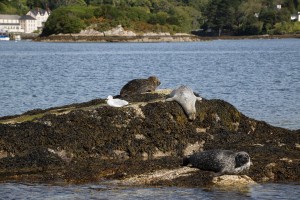
Cetaceans
A range of whales and dolphins (cetaceans) have been recorded in inner Bantry Bay. Species most commonly seen are porpoise, common dolphin, bottle-nose dolphin and minke whale. Ocasionally cetacean species have been known to strand in bay, most recently two northern bottlenose whales. This whale normally inhabits deep, offshore waters but on the 27th August 2009 two live stranded on Cusroe, Whiddy and subsequently died.
Fish and mussels
The lines of barrels in the inner bay are the visual sign of an extensive industry growing rope-grown edible mussels (Mytilus edulis). Bantry Bay is one of the main areas in Ireland for this type of aquaculture. The bay is also a known spawning ground for autumn-spawning herring (Clupea harengus). Other fish occurring include mackerel, pollack, dog-fish, mullet and ballan wrasse. Commercially caught species include Dublin bay prawn.
Golf
The appetites of golf lovers are more than satisfied when they feast their eyes upon our lavish courses. Bantry Bay Golf Club is a demanding 18 hole course, designed by Christy O’Connor, Jnr. Just outside Castletownbere is Berehaven Golf Club with a magnificent view of Bere Island and Berehaven Harbour. It is a nine-hole golf course. Glengarriff’s nine holes are in one of the loveliest settings in Ireland, with scenic views abounding – the one from the fifth tee is exceptionally beautiful.
Fishing and Angling
Shore fishing has become very popular in the area due to the large variety of fish being caught – conger eels, brown dogfish, spotted dogfish, cod, pollock, ray, skate, ling, and other varieties. For those interested in sea angling boats are available for daily hire.
For the lake and river fishing enthusiasts there are two of the best fishing lakes in Ireland for brown and rainbow trout as well as coarse fish and there are six rivers which are noted for salmon and sea trout fishing. Licences for fishing can be obtained in the local fish-tackle shops.
Water Sports & Sailing
Bantry Bay is one of the finest and safest harbours in Europe, being very deep with few dangerous rocks or sand banks and sheltered from most winds by the mountains surrounding it.
As a venue for water sports, Bantry Bay has a lot to offer, with many international sailing events taking place in recent years. The Beach area in the harbour is one of the best slalom windsurfing venues in the country and the national championships have been held here on a number of occasions.
Local companies provide a wide range of water sport activities. Should you crave adventure during the summer, look no further than along the magnificent coast around Bantry.



